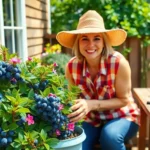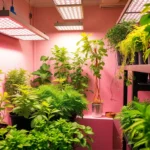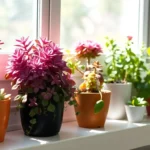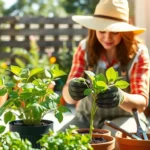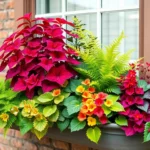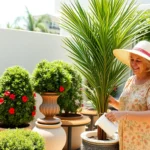Transform your windows into thriving indoor gardens with the perfect window shelf for plants. We’ve discovered that these ingenious answers maximize your growing space while creating stunning natural displays that catch every ray of precious sunlight. Whether you’re working with limited floor space or simply want to showcase your green collection more effectively, window plant shelves offer the ideal blend of functionality and style.
Window shelves aren’t just practical—they’re game-changers for plant enthusiasts who want to optimize their indoor growing conditions. We’ll explore how these versatile additions can accommodate everything from delicate succulents to cascading trailing plants, all while maintaining easy access for daily care routines.
Ready to elevate your plant game and create Instagram-worthy window displays? We’re diving into everything you need to know about choosing installing and styling the perfect window shelf system for your botanical collection.
Choose the Right Window Shelf Material for Your Plants
Selecting the perfect material for your window shelf directly impacts both your plants’ health and your home’s aesthetic appeal. We’ll explore the three most popular options that combine functionality with style to help you make the best choice for your indoor garden.
Wood Window Shelves for Natural Appeal
Wood window shelves complement any decor style while providing excellent support for your plant collection. Cedar and teak offer natural water resistance that prevents warping when exposed to humidity from watering routines. Pine and oak varieties work well in drier climates but require regular sealing to maintain their appearance.
Natural wood grains create warmth in your space and pair beautifully with ceramic planters and woven baskets. We recommend choosing hardwoods like maple or cherry for heavier plants such as fiddle leaf figs or rubber trees. Softwoods like pine work perfectly for lighter plants including pothos and spider plants.
Maintenance requirements include periodic oiling or staining to protect against moisture damage. Wood shelves typically last 5-10 years with proper care and can support 15-25 pounds per linear foot depending on the species and thickness.
Metal Window Shelves for Modern Durability
Metal window shelves deliver exceptional strength and contemporary styling that suits modern homes perfectly. Stainless steel and powder-coated aluminum resist rust and corrosion while supporting heavier plant arrangements. Wrought iron options provide classic elegance but require more maintenance in humid environments.
Weight capacity significantly exceeds other materials with most metal shelves supporting 30-50 pounds per linear foot. This makes them ideal for large planters containing monstera deliciosa or bird of paradise plants. We’ve found that metal construction allows for longer spans without additional brackets.
Style versatility ranges from sleek minimalist designs to ornate decorative patterns that enhance your window’s architectural features. Black and white finishes remain most popular though bronze and copper tones add warmth to traditional spaces. Metal shelves typically cost 20-40% more than wood but last 15-20 years with minimal maintenance.
Glass Window Shelves for Maximum Light
Glass window shelves maximize sunlight penetration to lower plant levels while creating an airy, sophisticated appearance. Tempered glass provides safety and strength while maintaining crystal clarity that won’t obstruct your view. We recommend 8mm thickness for standard plant loads and 10mm for heavier arrangements.
Light transmission reaches nearly 100% with quality glass, benefiting light-hungry plants like succulents and herbs positioned on multiple shelf levels. This material works exceptionally well for propagation stations where small cuttings need maximum exposure. Glass shelves prevent shadows that can limit growth on lower tiers.
Installation considerations require specialized brackets designed for glass mounting to ensure proper support and safety. Most glass shelves support 10-20 pounds per linear foot and work best with lightweight planters made from plastic or small ceramic pots. Professional installation often costs $50-100 more than other materials but provides peace of mind for safety compliance.
Measure Your Window Space Before Installing a Plant Shelf
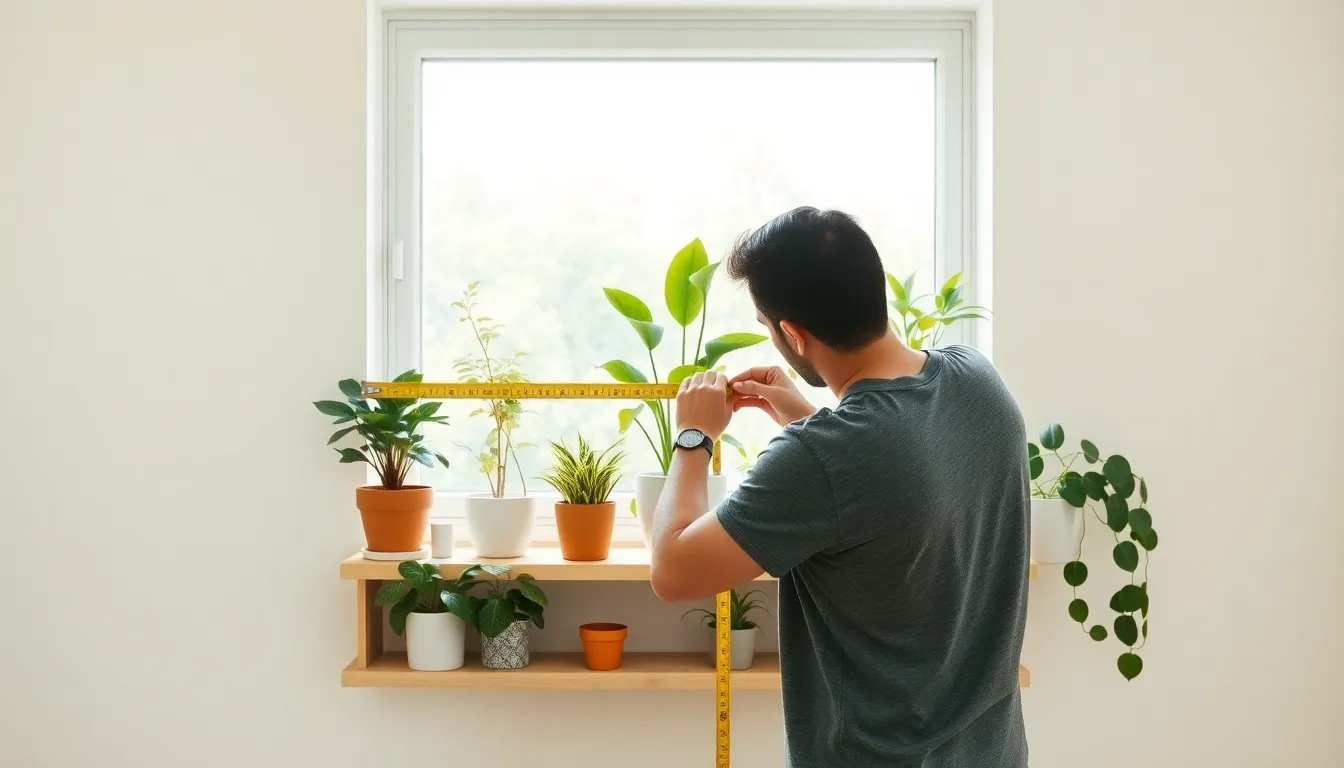
Proper measurements form the foundation of any successful window shelf installation. We’ll need to gather exact dimensions and consider several key factors to ensure our plant shelf fits perfectly and functions safely.
Determine Window Sill Depth Requirements
Depth calculations depend entirely on your plant collection’s size and growth patterns. We recommend measuring the diameter of your largest pots first, then adding at least 2 inches for safety clearance. A 4-inch deep shelf works exceptionally well for most small to medium houseplants without creating an overly bulky appearance.
Standard lumber dimensions offer convenient sizing options for DIY projects. Common 1×6 lumber provides approximately 5.5 inches of actual width, making it ideal for accommodating various pot sizes. We should account for any window trim or molding that might reduce the available depth, ensuring our plants won’t hang over the edge precariously.
Multiple plant arrangements require strategic depth planning. Consider staggering different sized pots or creating tiered displays that maximize your growing space while maintaining visual appeal.
Calculate Weight Capacity for Multiple Plants
Weight distribution becomes critical when supporting several water-filled planters simultaneously. We need to calculate the combined weight of soil, pots, and water to determine appropriate support requirements. A typical 6-inch pot with moist soil weighs approximately 3-5 pounds, while larger 10-inch containers can reach 15-20 pounds.
Material selection directly impacts load-bearing capacity and long-term stability. Butcher block wood and 2×4 lumber boards provide superior strength compared to thin decorative boards that may sag under heavy plant loads. Steel pipes and metal flanges offer the most durable support system for substantial plant collections.
Mounting methods significantly affect overall weight capacity and structural integrity. Securing brackets directly to window trim or frame members increases strength substantially. We should use appropriate wall anchors rated for the expected load, typically requiring anchors that support at least double our calculated plant weight for safety margins.
Consider Window Opening Clearance
Window functionality must remain uncompromised by our plant shelf installation. We need to measure the clearance between our proposed shelf location and the window’s opening mechanism. Leave at least 2-3 inches of space to ensure smooth operation without plant interference.
Inside-mounted shelves require precise fitting around existing window molding. Trimming shelf edges to accommodate trim creates a clean, professional appearance while maintaining necessary clearances. Low-profile supports like cove molding keep installations slim and unobtrusive.
Moveable shelf designs provide maximum flexibility for seasonal adjustments. These systems allow us to shift plants closer to or further from windows based on lighting needs without permanently blocking access. Consider removable or adjustable brackets that accommodate changing plant arrangements throughout the year.
Select Plants That Thrive on Window Shelves
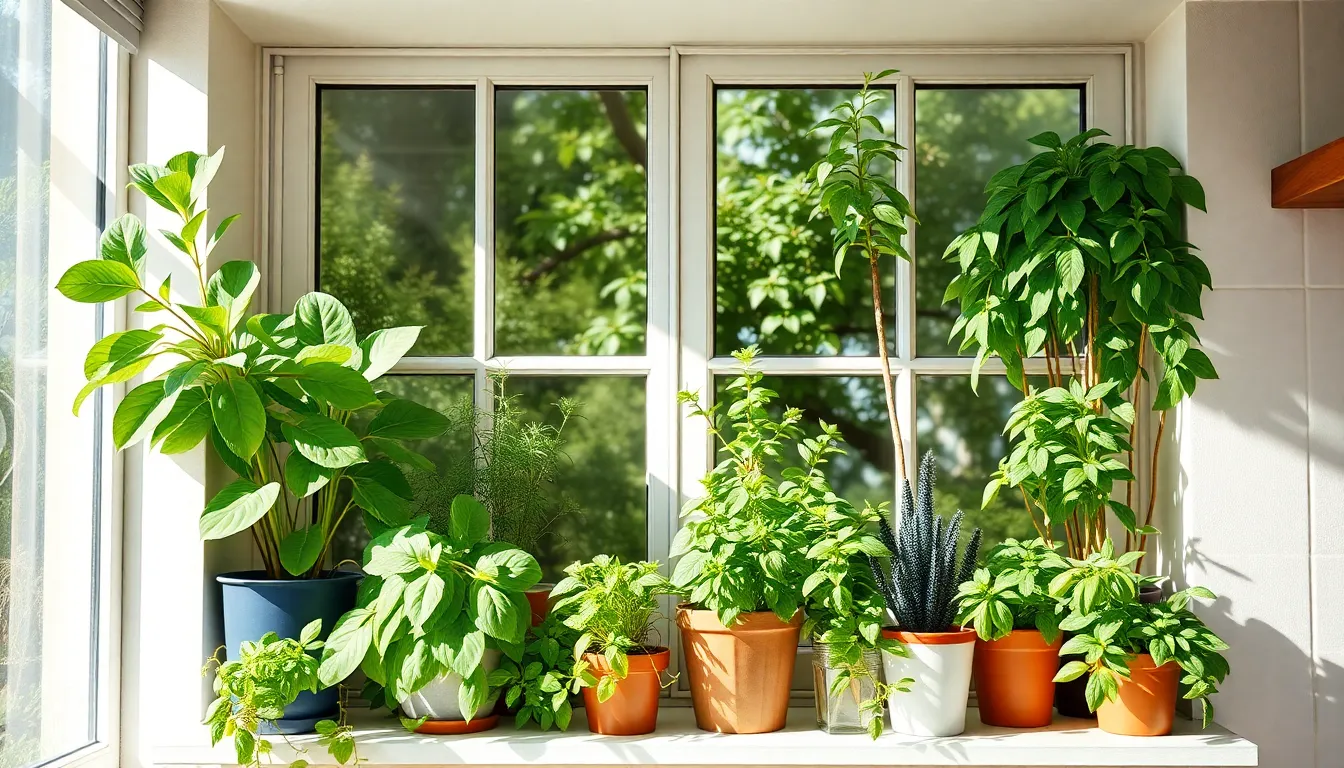
Choosing the right plants for your window shelf setup determines the success of your indoor garden. We’ll match exact plant varieties to your window’s light conditions and room environment for optimal growth.
Low-Light Plants for North-Facing Windows
Prayer Plants offer stunning patterned foliage that creates visual interest in darker spaces. We recommend Maranta species because they tolerate partial to low light conditions while maintaining their attractive leaf patterns that fold dramatically at night. Keep the soil consistently moist for best results.
Rattlesnake Calathea brings compact elegance to north-facing window shelves with its unique lance-shaped leaves. This variety thrives in low light environments and requires regular watering to maintain moist soil conditions. The distinctive foliage patterns make it a standout choice for darker windowsills.
Baby Tears create a delicate cascade effect with their tiny spreading leaves. We find this plant perfect for adding texture to shaded windows since it loves consistently moist soil and low light conditions. The fine foliage adds softness to any shelf arrangement.
Snake Plants provide versatility across various light levels while requiring minimal maintenance. Many Sansevieria varieties adapt well to lower light environments and tolerate infrequent watering. These hardy plants serve as reliable anchor pieces in any north-facing window display.
Sun-Loving Plants for South-Facing Windows
Succulents maximize the bright conditions of south-facing windows while requiring minimal water. Various types flourish in direct sunlight and create stunning displays when grouped together. Allow the soil to dry completely between waterings for healthy growth.
Herbs like basil, mint, thyme, and rosemary transform window shelves into functional kitchen gardens. We grow these culinary plants in south-facing windows because they need 6+ hours of direct sunlight daily. Regular harvesting keeps them productive while frequent watering maintains healthy growth.
Spider Plants and Pothos adapt beautifully to bright indirect or partial direct light conditions. These popular houseplants tolerate various lighting situations while producing attractive trailing growth. Both varieties work well as statement pieces in sunny window arrangements.
Humidity-Loving Plants for Kitchen Windows
Calatheas and Prayer Plants excel in kitchen environments where cooking creates natural humidity. We place these moisture-loving plants near kitchen windows with indirect light because they thrive in higher humidity levels. Keep their soil consistently moist for optimal leaf development.
Air Plants eliminate the need for traditional potting while absorbing moisture directly from humid air. Tillandsia varieties require no soil and do well with bright indirect light plus occasional soaking every 1-2 weeks. These unique plants add sculptural interest to kitchen window displays.
Peperomia varieties offer compact growth with thick leaves that handle humidity fluctuations well. We choose these pet-safe plants for kitchen shelves because they prefer bright indirect light without direct sun exposure. Allow the soil to partially dry between waterings for healthy root development.
| Plant Type | Light Requirement | Watering Needs | Ideal Window Type | Notes |
|---|---|---|---|---|
| Prayer Plant | Partial to low light | Keep soil moist | North or indirect light | Folds leaves at night |
| Rattlesnake Calathea | Low light | Keep soil moist | North or indirect light | Unique foliage |
| Baby Tears | Low light | Consistently moist | North or shaded windows | Delicate foliage |
| Succulents | Full sun | Allow soil to dry | South-facing | Minimal water |
| Herbs (Basil, etc.) | Full sun | Keep soil moist | South-facing | Regular pruning/harvesting |
| Air Plants | Bright indirect | Soak every 1-2 weeks | Kitchen or bright windows | No soil needed |
| Peperomia | Bright indirect | Allow partial drying | Kitchen or bright windows | Pet-safe |
| Snake Plants | Low to bright light | Low watering | Various | Very hardy |
Install Your Window Shelf for Plants Safely
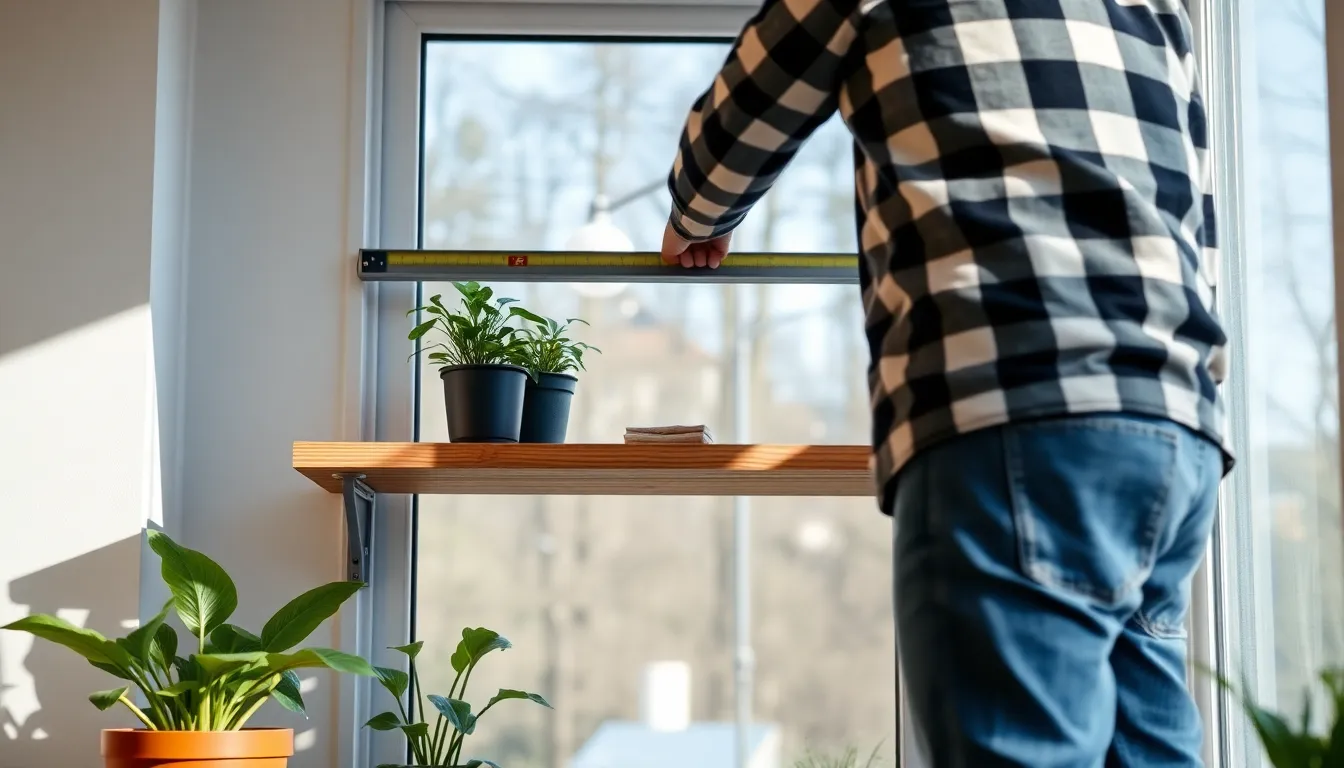
Now that we’ve selected our materials and measured our space, let’s walk through the critical installation steps that’ll ensure your window shelf remains secure and functional for years to come.
Mount Brackets Securely to Window Frame
Mounting brackets directly into the window frame provides the strongest foundation for your plant shelf. We recommend using screws that penetrate at least 1 inch into solid wood framing to handle the combined weight of plants, water, and the shelf itself.
Position your brackets using a measuring tape to ensure they’re perfectly aligned with your shelf dimensions. Mark the screw holes with a pencil before drilling pilot holes to prevent the wood from splitting during installation.
Choose brackets that match your shelf material and aesthetic preferences. L-brackets work exceptionally well for simple installations, while small cove molding pieces create a floating shelf effect that blends seamlessly with existing window trim.
Verify that each bracket sits flush against the window frame before tightening screws completely. This step prevents wobbling and ensures maximum contact between the bracket and supporting structure.
Level Your Shelf for Proper Water Drainage
Leveling your shelf precisely prevents water from pooling in one area, which can damage both your shelf and window area over time. We use a standard bubble level to check both the length and width of the shelf during installation.
Place the level along the front edge of your shelf first, then check the side-to-side alignment. Adjust bracket positions as needed until the bubble sits perfectly centered in both directions.
Water drainage becomes critical when multiple plants sit on the same surface. Even slight slopes can cause water to accumulate, leading to wood rot, paint damage, or structural issues with your window frame.
Apply a waterproof or water-resistant finish to wooden shelves before installation. Paint or stain creates a protective barrier that prevents moisture damage while maintaining the shelf’s appearance.
Test Weight Limits Before Adding Plants
Testing your shelf’s weight capacity prevents accidents and ensures plant safety throughout the growing season. We recommend starting with empty pots and gradually adding soil and plants to monitor any signs of sagging or instability.
Begin by placing your heaviest planters on the shelf one at a time. Watch for any visible bending, creaking sounds, or movement in the brackets that might indicate the shelf is approaching its weight limit.
Distribute weight evenly across the entire shelf surface rather than concentrating multiple heavy plants in one area. This approach maximizes the shelf’s load-bearing capacity and prevents stress concentration points.
Remove plants immediately if you notice any structural concerns during testing. It’s better to reduce the plant load than risk damage to your window, plants, or flooring below.
Arrange Plants on Your Window Shelf for Optimal Growth
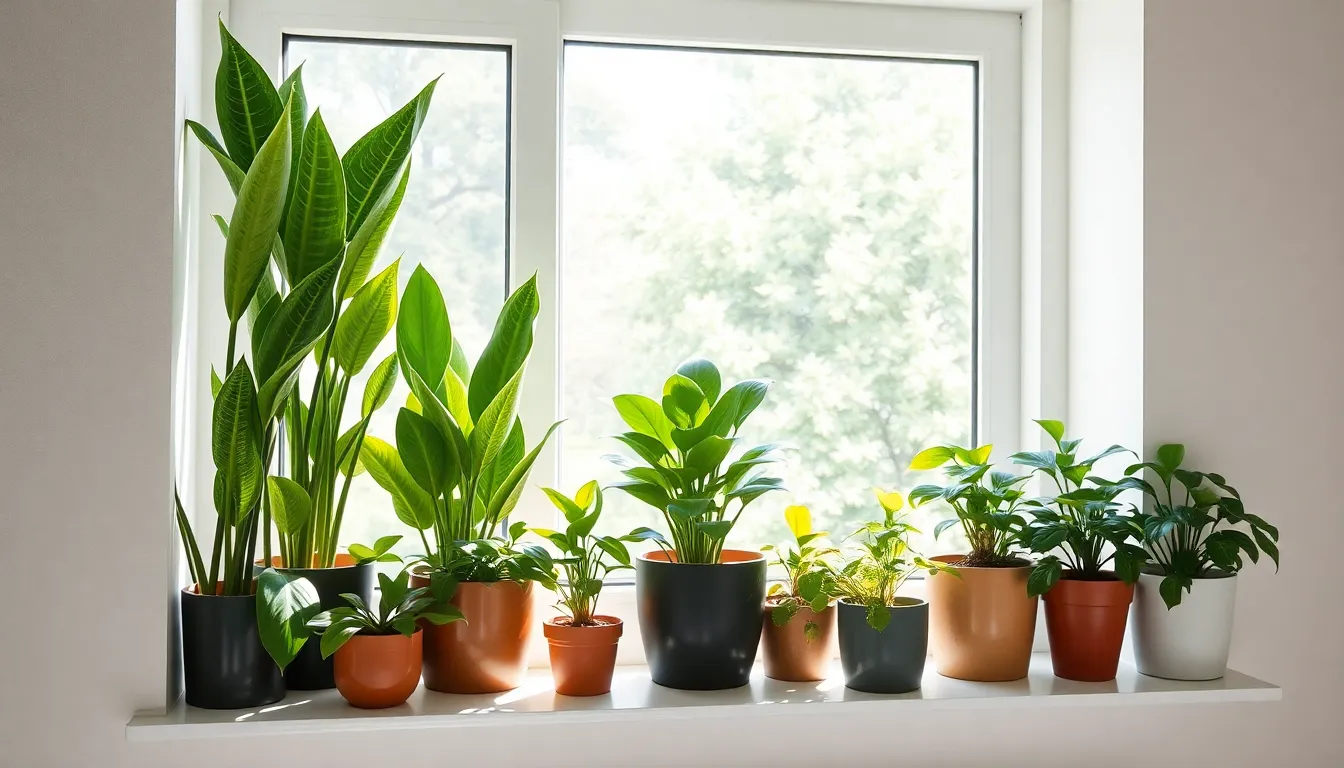
Once your window shelf is properly installed and ready, the strategic placement of your plants becomes crucial for creating a thriving indoor garden. Smart arrangement techniques maximize light exposure while ensuring each plant receives proper care.
Place Taller Plants in Back for Light Access
Position your tallest plants toward the back of the window shelf to create an effective tiered lighting system. This arrangement prevents taller specimens from casting shadows on shorter plants positioned in front.
Placing larger plants like Snake Plants or tall succulents along the back edge allows sunlight to reach every level of your display. Your shorter plants such as small Pothos or compact herbs can then occupy the front positions where they’ll receive unobstructed light.
Consider the mature size of each plant when planning your arrangement. Plants that grow upward rather than outward work best in back positions since they won’t spread and block neighboring plants as they develop.
Group Plants by Watering Requirements
Organize plants with similar watering schedules together to streamline your care routine and prevent watering mistakes. Grouping drought tolerant succulents on one section of your shelf keeps them separate from moisture loving plants like Calatheas.
Place water hungry plants such as Baby Tears and Prayer Plants in the same area where you can easily monitor their soil moisture levels. Your low maintenance plants like Snake Plants can occupy a different section where they won’t accidentally receive too much water during routine care.
This strategic grouping approach reduces the risk of overwatering drought tolerant plants or underwatering those that need consistent moisture. You’ll find plant care becomes more efficient when similar needs are clustered together.
Leave Space for Air Circulation
Allow adequate gaps between each plant to promote healthy airflow throughout your window shelf display. Proper spacing prevents the buildup of humidity that can lead to mold, mildew, and pest problems around your plant collection.
Position plants so their leaves don’t touch neighboring specimens, creating natural air channels between each pot. This spacing becomes especially important for plants with dense foliage that can trap moisture if placed too closely together.
Maintain at least 2 to 3 inches between pot edges to ensure sufficient air movement. Your plants will develop stronger stems and healthier growth patterns when they have room to breathe and aren’t competing for air circulation space.
Maintain Your Window Plant Shelf System
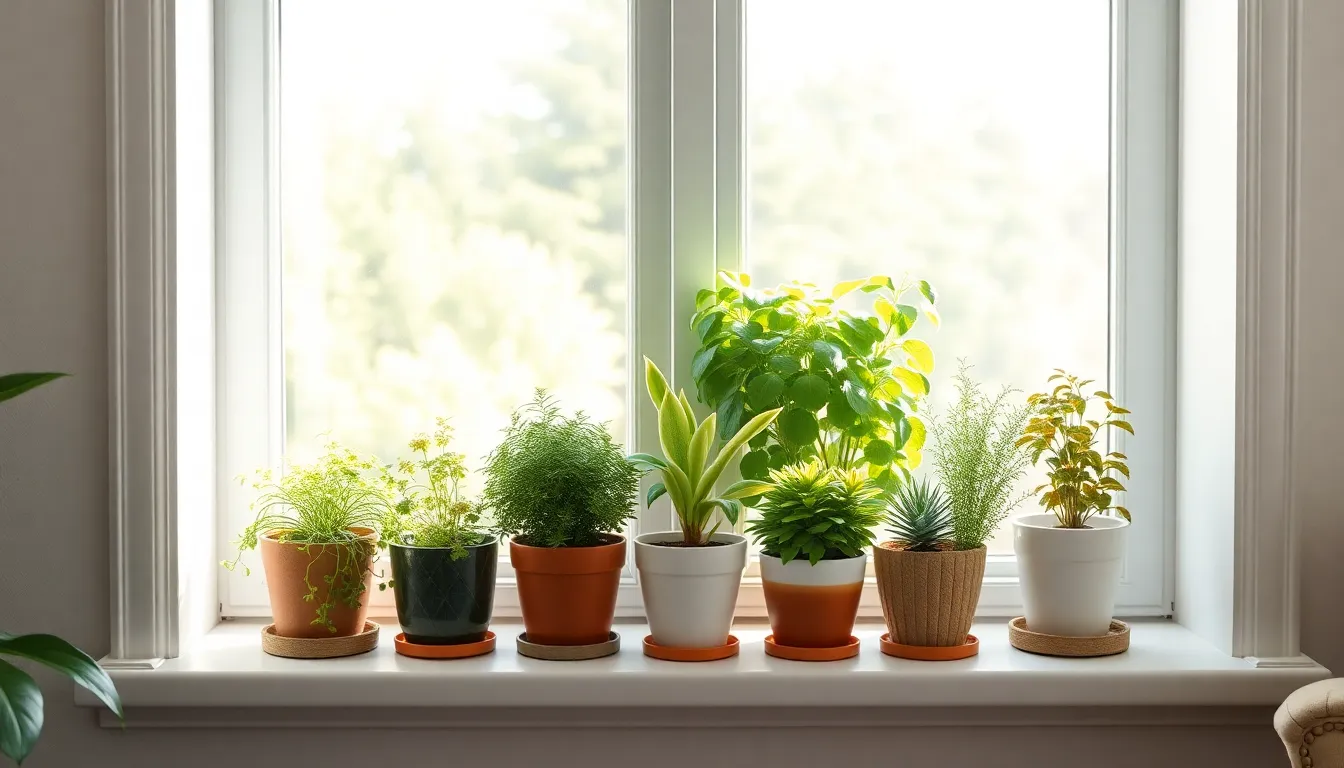
Proper maintenance keeps your window plant shelf system healthy and functional for years to come. We’ll focus on three essential maintenance practices that protect both your plants and shelving investment.
Clean Shelf Surfaces to Prevent Mold
Regular cleaning prevents mold growth and maintains your shelf’s appearance. Wipe down surfaces with a damp cloth weekly to remove accumulated dirt and plant debris. Dust particles and moisture create ideal conditions for mold development if left unchecked.
Wooden shelves require specialized cleaning products to avoid damage. Use wood-safe cleaners that won’t strip the finish or cause warping. Avoid harsh chemicals that can penetrate wood grain and create long-term deterioration.
Focus on areas where water tends to collect during your cleaning routine. Corner joints and edges typically accumulate more moisture than flat surfaces. Pay special attention to spots where plant saucers sit regularly.
Rotate Plants for Even Sun Exposure
Rotating plants every few days ensures uniform growth and prevents lopsided development. Turn each plant a quarter rotation to expose different sides to direct sunlight. This simple practice prevents one side from becoming weak or leggy while the other thrives.
Combine plant rotation with your regular watering schedule for efficiency. Check soil moisture and rotate plants simultaneously to streamline your care routine. This approach helps you remember both tasks without creating additional work.
Watch for signs of uneven growth that indicate insufficient rotation. Plants leaning toward the window or showing yellowing on the back side need more frequent turning. Adjust your rotation schedule based on how quickly your exact plants respond to light changes.
Monitor for Water Damage on Wooden Shelves
Place saucers or trays under all pots to catch excess water and protect shelf surfaces. Water damage can warp wood, cause staining, and weaken structural integrity over time. Even small amounts of moisture can create problems if allowed to accumulate.
Check soil moisture regularly since plants on higher shelves dry out faster than those at lower levels. Upper shelves receive more direct sunlight and air circulation, increasing water evaporation rates. Adjust watering frequency based on shelf position and plant needs.
Consider pots without drainage holes for extra protection, but monitor soil conditions carefully. This approach eliminates water overflow but requires precise watering to prevent root rot. Check the bottom inch of soil regularly to ensure you’re not overwatering plants in sealed containers.
Style Your Window Shelf for Plants Decoratively
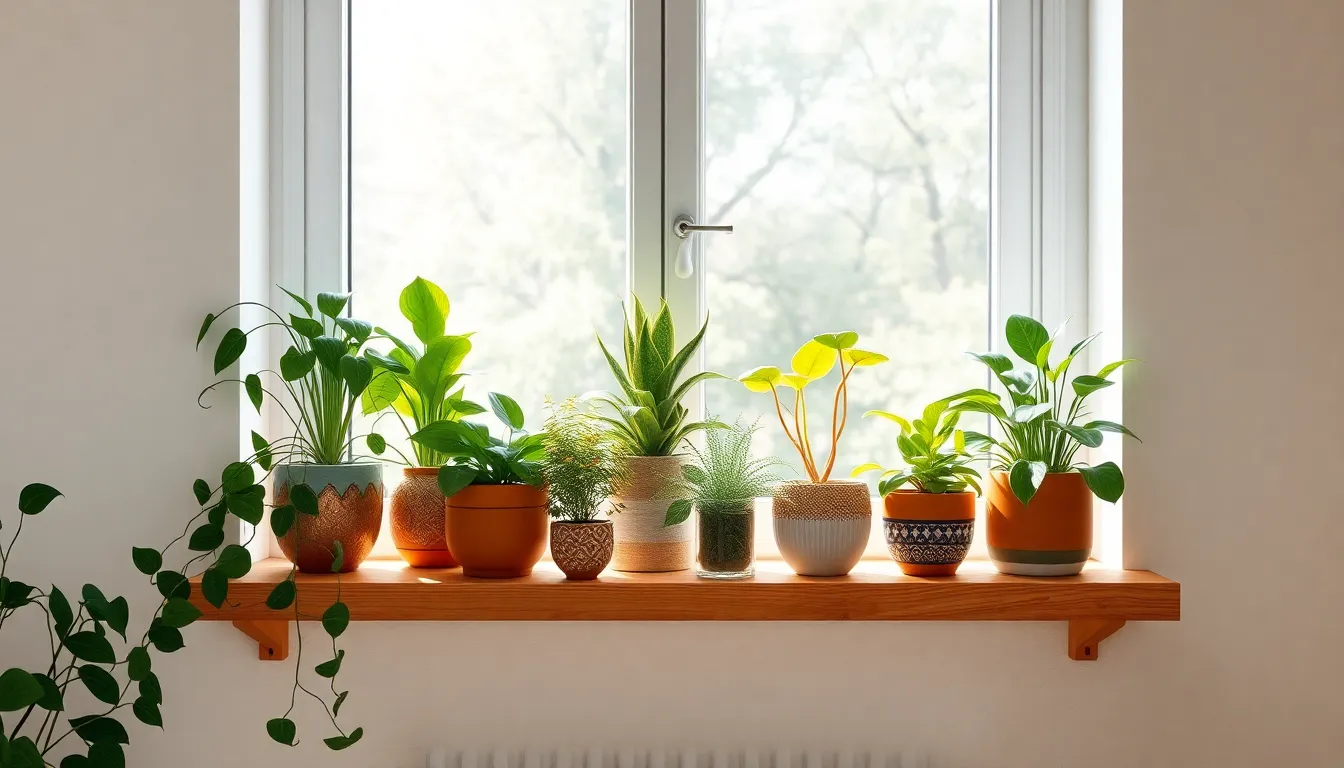
Transforming your window shelf into a stunning display requires thoughtful decorative choices that complement both your plants and room aesthetics. Creating visual appeal while maintaining plant health becomes achievable when you focus on key styling elements.
Add Decorative Planters and Containers
Decorative planters elevate your window shelf display by adding personality and style to your plant collection. Choosing attractive pots and containers creates visual cohesion while highlighting each plant’s unique characteristics. We recommend selecting styles and colors that complement your existing room decor, from rustic wooden planters that add warmth to sleek modern ceramic pots that provide contemporary appeal.
Layering different sizes and textures creates compelling visual interest across your shelf arrangement. Mix and match various pot heights, materials, and finishes to establish depth and dimension. Terra cotta pots pair beautifully with glazed ceramics, while woven baskets add natural texture alongside smooth stone containers.
Strategic color coordination helps tie your plant display into your overall interior design scheme. Select neutral tones like whites, grays, and natural browns for versatile appeal, or choose bold accent colors that echo existing room elements like throw pillows or artwork.
Incorporate Trailing Plants for Visual Interest
Trailing plants such as pothos, ivy, or string of pearls add ever-changing movement and softness to your window shelf arrangement. These cascading varieties create natural lines that draw the eye downward, balancing the upright structure of standard potted plants. Their flowing vines introduce organic curves that soften angular shelf edges and window frames.
Positioning trailing plants at shelf edges maximizes their decorative impact while creating layered visual depth. Allow their vines to cascade freely over the shelf front, creating a lush waterfall effect that adds vibrancy to your window space. This placement also helps frame your other plants while establishing natural boundaries within your display.
Mixing trailing varieties with upright plants creates balanced compositions that feel both structured and organic. Combine fast growing pothos with slower growing string of hearts to achieve varied textures and growth patterns throughout your arrangement.
Match Shelf Style to Room Decor
Choosing a shelf design that matches your interior style ensures seamless integration with your existing room aesthetics. Natural wood shelves complement rustic or boho themes perfectly, while minimal glass or acrylic shelves enhance modern spaces with their clean, transparent appearance. Industrial pipe shelves add urban sophistication to loft style interiors or contemporary designs.
Installation options provide flexibility to accommodate different window configurations and design preferences. Freestanding shelves work well on wide windowsills, while wall mounted options beside or beneath windows maximize vertical space. Swivel designs that pivot out offer easy plant access while maintaining sleek profiles when closed.
Consider your room’s existing materials and finishes when selecting shelf construction. Match wood tones to nearby furniture pieces, coordinate metal finishes with existing hardware, or choose glass shelves that virtually disappear while supporting your plants. This thoughtful coordination creates cohesive design flow throughout your space.
Troubleshoot Common Window Plant Shelf Problems
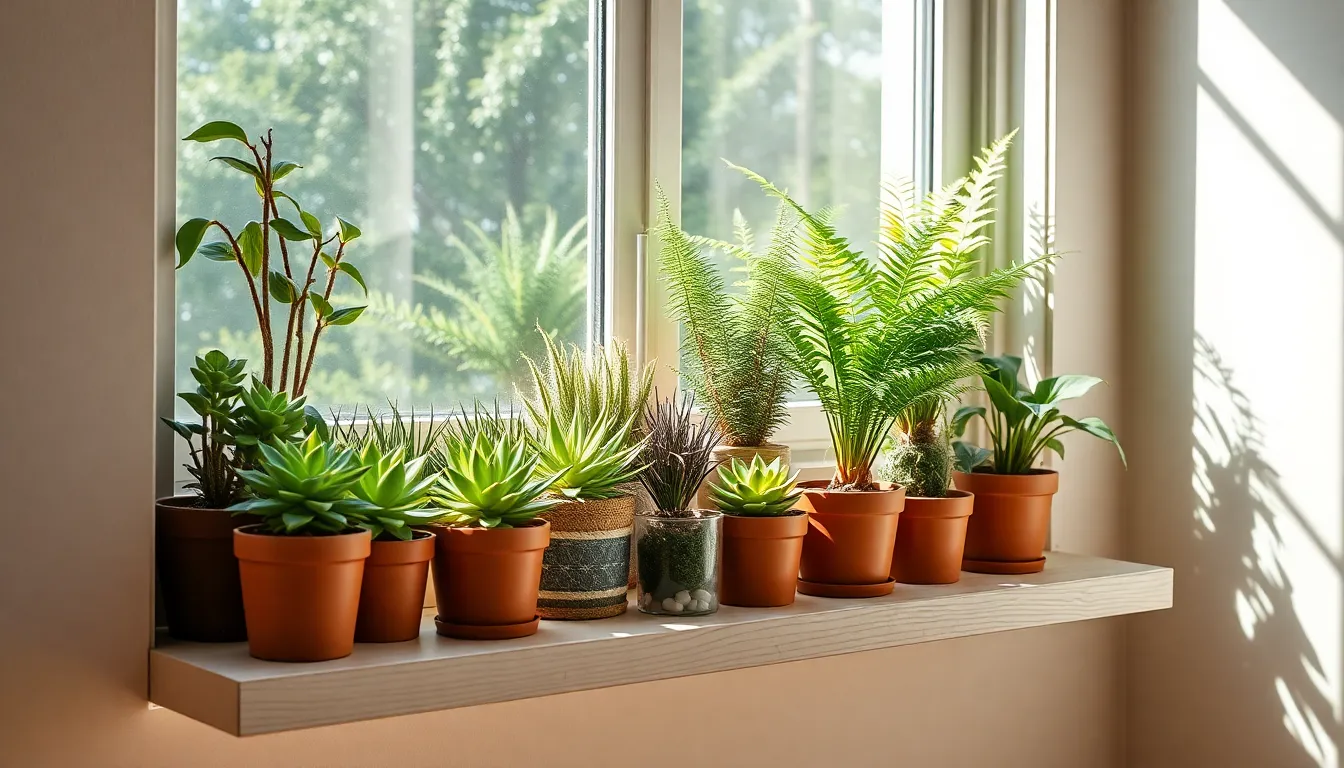
Even the most carefully planned window plant shelves can develop issues that affect plant health and growth. We’ll help you identify and solve the most common problems that arise with window shelf gardening.
Address Overcrowding Issues
Overcrowding creates competition for light and nutrients while restricting essential airflow around your plants. We recommend spacing plants adequately to allow proper air circulation between each container. Plants need breathing room to thrive, so avoid the temptation to cram every available inch with greenery.
Rotating plants regularly ensures even light exposure and prevents lopsided growth patterns. We suggest turning each plant a quarter turn every week so all sides receive equal sunlight. This simple practice keeps plants growing straight and healthy rather than leaning toward the window.
Pruning plants routinely maintains compact shapes and prevents overgrowth on limited shelf space. We trim back leggy stems and remove dead or yellowing leaves to keep plants manageable. Regular pruning also encourages bushier growth and prevents plants from shading their neighbors.
Fix Drainage Problems
Proper drainage prevents root rot and fungal issues that commonly affect window shelf plants. We always use pots with drainage holes to allow excess water to escape freely. Containers without drainage create waterlogged soil conditions that kill plant roots.
Placing a layer of small stones at the bottom of pots creates false drainage before adding soil. We add this drainage material to improve water flow and prevent soil from becoming compacted. This technique works especially well for plants that prefer well-draining conditions.
Watering only when soil feels dry to the touch prevents overwatering problems. We check soil moisture by inserting our finger about an inch deep into the potting mix. Most window shelf plants prefer slightly dry conditions between waterings rather than constantly moist soil.
Repotting plants with fresh soil and proper drainage materials solves persistent drainage issues. We replace old, compacted soil with fresh potting mix and ensure adequate drainage holes exist. This refresh gives plants a healthy foundation for continued growth.
Prevent Plant Diseases in Confined Spaces
Good ventilation reduces humidity buildup that promotes fungal growth in confined window spaces. We ensure air can circulate freely around our plant shelves by avoiding overcrowding and positioning fans nearby if needed. Stagnant air creates perfect conditions for plant diseases to develop and spread.
Treating plants periodically with antifungal agents prevents fungal infections before they start. We apply preventive treatments especially before winter dormancy when plants become more susceptible to disease. This proactive approach saves us from dealing with more serious problems later.
Monitoring plants for early disease signs allows us to isolate affected plants quickly. We inspect leaves regularly for spots, discoloration, or unusual growth patterns that indicate potential problems. Early detection prevents diseases from spreading to neighboring plants on the same shelf.
Adjusting care routines before winter helps plants enter dormancy healthy and disease-free. We stop fertilizing, reduce watering frequency, and treat plants against pests and fungi as temperatures drop. These preparations ensure our window shelf plants survive the challenging winter months successfully.
Conclusion
Window shelves transform ordinary windowsills into thriving plant havens that maximize natural light while adding life to our living spaces. We’ve covered everything from selecting durable materials and proper installation techniques to choosing the right plants for different light conditions.
The key to success lies in thoughtful planning – measuring carefully taking weight capacity seriously and grouping plants with similar care needs. Regular maintenance including cleaning rotation and monitoring for issues ensures our window gardens remain healthy and beautiful year-round.
With the right approach window plant shelves become both functional growing spaces and stunning decorative features. They’re an investment in our home’s beauty and our well-being creating peaceful green corners that connect us with nature every day.
Frequently Asked Questions
What are the best materials for window plant shelves?
The three most popular materials are wood, metal, and glass. Wood offers natural appeal and excellent support, with cedar and teak providing water resistance. Metal shelves provide modern durability and high weight capacity for larger plants. Glass shelves maximize light penetration and create an airy aesthetic, perfect for light-hungry plants, though they require specialized installation.
How do I measure my window for plant shelves?
Start by measuring your window sill depth and calculating the weight capacity needed for multiple plants. Measure the diameter of your largest pots and ensure at least 2 inches of safety clearance. Consider window opening clearance to maintain functionality, and opt for moveable shelf designs for flexibility in plant arrangements.
Which plants work best for north-facing window shelves?
North-facing windows receive less direct sunlight, making them perfect for low-light plants. Prayer Plants, Rattlesnake Calathea, Baby Tears, and Snake Plants thrive in these conditions. These plants adapt well to lower light levels and require less frequent watering, making them ideal for beginners.
What plants should I choose for south-facing window shelves?
South-facing windows receive abundant sunlight, perfect for sun-loving plants like succulents and culinary herbs. Spider Plants and Pothos are adaptable options that can handle varying light conditions. These plants typically require more frequent watering due to increased light exposure and faster growth rates.
How do I properly install window plant shelves?
Mount brackets directly into the window frame using screws that penetrate solid wood framing for maximum stability. Ensure proper alignment and leveling to prevent water pooling. Apply waterproof finish to wooden shelves and test weight limits before adding plants to ensure safety and prevent damage.
How should I arrange plants on my window shelves?
Place taller plants at the back to maximize light exposure and prevent shading shorter plants in front. Group plants with similar watering needs together to streamline care routines. Leave adequate space between plants for air circulation to promote healthy growth and prevent mold or pest issues.
What maintenance do window plant shelves require?
Regular cleaning prevents mold growth—use wood-safe cleaners for wooden shelves. Rotate plants regularly for even sun exposure and monitor for water damage. Use saucers to catch excess water and adjust watering frequency based on shelf position and seasonal changes.
How can I style my window plant shelves decoratively?
Use decorative planters that complement your room’s aesthetics and layer different sizes and textures for visual interest. Coordinate colors to enhance overall design and include trailing plants for movement and softness. Match shelf styles to your room decor for a cohesive, polished look.
What are common problems with window plant shelves?
Common issues include overcrowding, drainage problems, and plant diseases. Ensure adequate spacing for airflow, use pots with drainage holes, and add stone layers for improved water flow. Maintain good ventilation to reduce humidity and monitor plants regularly for early signs of disease or stress.


